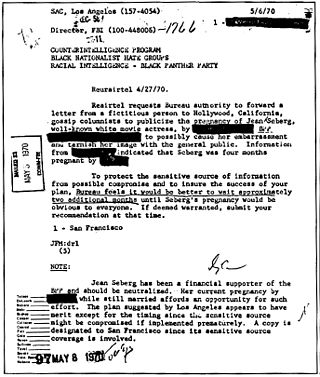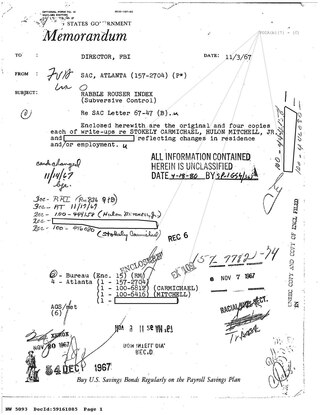Related Research Articles

COINTELPRO was a series of covert and illegal projects conducted between 1956 and 1971 by the United States Federal Bureau of Investigation (FBI) aimed at surveilling, infiltrating, discrediting, and disrupting American political organizations that the FBI perceived as subversive. Groups and individuals targeted by the FBI included feminist organizations, the Communist Party USA, anti–Vietnam War organizers, activists in the civil rights and Black power movements, environmentalist and animal rights organizations, the American Indian Movement (AIM), Chicano and Mexican-American groups like the Brown Berets and the United Farm Workers, independence movements, a variety of organizations that were part of the broader New Left, and white supremacist groups such as the Ku Klux Klan and the National States' Rights Party.
Continuity of Operations (COOP) is a United States federal government initiative, required by U.S. Presidential Policy Directive 40 (PPD-40), to ensure that agencies are able to continue performance of essential functions under a broad range of circumstances. PPD-40 specifies certain requirements for continuity plan development, including the requirement that all federal executive branch departments and agencies develop an integrated, overlapping continuity capability, that supports the eight National Essential Functions (NEFs) described in the document.

The Mount Weather Emergency Operations Center is a government command facility located near Frogtown, Clarke County, Virginia, used as the center of operations for the Federal Emergency Management Agency (FEMA). Also known as the High Point Special Facility (HPSF), its preferred designation since 1991 is "SF".

An insurgency is a violent, armed rebellion by small, lightly armed bands who practice guerrilla warfare against a larger authority. The key descriptive feature of insurgency is its asymmetric nature: small irregular forces face a large, well-equipped, regular military force state adversary. Due to this asymmetry, insurgents avoid large-scale direct battles, opting instead to blend in with the civilian population where they gradually expand territorial control and military forces. Insurgency frequently hinges on control of and collaboration with local populations.
Political repression is the act of a state entity controlling a citizenry by force for political reasons, particularly for the purpose of restricting or preventing the citizenry's ability to take part in the political life of a society, thereby reducing their standing among their fellow citizens. Repression tactics target the citizenry who are most likely to challenge the political ideology of the state in order for the government to remain in control. In autocracies, the use of political repression is to prevent anti-regime support and mobilization. It is often manifested through policies such as human rights violations, surveillance abuse, police brutality, imprisonment, involuntary settlement, stripping of citizen's rights, lustration, and violent action or terror such as the murder, summary executions, torture, forced disappearance, and other extrajudicial punishment of political activists, dissidents, or general population. Direct repression tactics are those targeting specific actors who become aware of the harm done to them while covert tactics rely on the threat of citizenry being caught. The effectiveness of the tactics differ: covert repression tactics cause dissidents to use less detectable opposition tactics while direct repression allows citizenry to witness and react to the repression. Political repression can also be reinforced by means outside of written policy, such as by public and private media ownership and by self-censorship within the public.

The United States Northern Command (USNORTHCOM) is one of eleven unified combatant commands of the United States Department of Defense. The command is tasked with providing military support for non-military authorities in the U.S., and protecting the territory and national interests of the United States within the continental United States, Puerto Rico, Canada, Mexico, The Bahamas, and the air, land and sea approaches to these areas. It is the U.S. military command which, if applicable, would be the primary defender against an invasion of the U.S.
Reid v. Covert, 354 U.S. 1 (1957), was a 6–2 landmark decision of the United States Supreme Court holding that United States citizen civilians outside of the territorial jurisdiction of the United States cannot be tried by a United States military tribunal, but instead retain the protections guaranteed by the United States Constitution, in this case, trial by jury. Additionally, a plurality of the Court also reaffirmed the president’s ability to enter into international executive agreements, though it held that such agreements cannot contradict federal law or the Constitution.

The United States under secretary of defense for policy (USDP) is a high level civilian official in the United States Department of Defense. The under secretary of defense for policy is the principal staff assistant and adviser to both the secretary of defense and the deputy secretary of defense for all matters concerning the formation of national security and defense policy.
Transition to war (TTW) is a North Atlantic Treaty Organization (NATO) military term referring to a period of international tension during which government and society move to an open war footing. The period after this is considered to be war, conventional or otherwise, but the term TTW found its origins in the peak of the Cold War as a key NATO concept within the tripwire escalation of the DEFCON status. This could include the suspension of peacetime services, closing motorways to all but military traffic and the internment of subversives without charge or trial. The Federal Emergency Management Agency would declare this period as Increased Readiness in a move to expedite Civil Defense training, among other things in order to prepare civil authorities for a nuclear attack, and to an extent is similar to Transition to War.

The Daniel K. Inouye Asia-Pacific Center for Security Studies is a U.S. Department of Defense institute that officially opened Sept. 4, 1995, in Honolulu, Hawaii. The Center addresses regional and global security issues, inviting military and civilian representatives of the United States and Asia-Pacific nations to its comprehensive program of executive reeducation and workshops, both in Hawaii and throughout the Asia-Pacific region.
Presidential Decision Directive 62 (PDD-62), titled Combating Terrorism, was a Presidential Decision Directive (PDD), signed on May 22, 1998 by President Bill Clinton. It identified the fight against terrorism a top national security priority.

The FBI Indexes, or Index List, was a system used to track American citizens and other people by the Federal Bureau of Investigation (FBI) before the adoption of computerized databases. The Index List was originally made of paper index cards, first compiled by J. Edgar Hoover at the Bureau of Investigations before he was appointed director of the FBI. The Index List was used to track U.S. citizens and others believed by the FBI to be dangerous to national security, and was subdivided into various divisions which generally were rated based on different classes of danger the subject was thought to represent.
The United States has at various times in recent history provided support to terrorist and paramilitary organizations around the world. It has also provided assistance to numerous authoritarian regimes that have used state terrorism as a tool of repression.
The Jade Helm 15 conspiracy theories were based on the Jade Helm 15 United States military training exercise which took place in multiple U.S. states between July 15 and September 15, 2015. The exercise, which involved 1,200 personnel from four of the five branches of the U.S. military, was designed to train soldiers in skills needed to operate in overseas combat environments, including maneuvering through civilian populations. The announcements of these training exercises raised concerns and generated conspiracy theories, mostly from Alex Jones, that the exercise was a hostile military takeover.
The FEMA camps conspiracy theory is a belief, particularly within the American Patriot movement, that the United States Federal Emergency Management Agency (FEMA) is planning to imprison US citizens in concentration camps, following the imposition of martial law in the United States after a major disaster or crisis. In some versions of the theory, only suspected dissidents will be imprisoned. In more extreme versions, large numbers of US citizens will be imprisoned for the purposes of extermination as a New World Order is established. The theory has existed since the late 1970s, but its circulation has increased with the advent of the internet and social media platforms.
Federal Emergency Plan D-Minus was a plan developed by the United States in the 1950s to guide the federal government in the immediate aftermath of a catastrophic nuclear attack. Plan D-Minus was part of the National Plan for Emergency Preparedness, which also included Mobilization Plan C.
Operation Gotham Shield was a 2017 exercise conducted by the United States Federal Emergency Management Agency (FEMA) which tested civil defense response capabilities to a nuclear weapons attack against the New York City metropolitan area.
United States ex rel. Toth v. Quarles, 350 U.S. 11 (1955), was a decision by the Supreme Court of the United States that expanded the rights of citizens to civilian trials, holding that an ex-serviceman cannot be court-martialed for crimes alleged during his military service.
Presidential Emergency Action Documents (PEADs) are draft classified executive orders, proclamations, and messages to Congress that are prepared for the President of the United States to exercise or expand powers in anticipation of a range of emergency hypothetical worst-case scenarios, so that they are ready to sign and put into effect the moment one of those scenarios comes to pass. They are defined by the Federal Emergency Management Agency as the "Final drafts of Presidential messages, proposed legislation proclamations, and other formal documents, including DOJ-issued cover sheets addressed to the President, to be issued in event of a Presidentially-declared national emergency."
References
- ↑ Sheehan, Daniel (2013). The People's Advocate. Berkeley, CA: Counterpoint Publishing. p. 439. ISBN 978-1-61902-172-3.
- ↑ Ridenhour, Ron (1975). "Garden Plot and the New Action Army". CounterSpy.
- ↑ Ross Gelbspan (1991). Break-ins, death threats and the FBI: the covert war against the central America movement . South End Press. p. 184. ISBN 978-0-89608-412-4 . Retrieved 2016-10-19.
- ↑ Holly Sklar (1988). Washington's war on Nicaragua . South End Press. pp. 357–359. ISBN 978-0-89608-295-3 . Retrieved 2016-10-19.
- ↑ Ward Churchill; Jim Vander Wall (2002). The COINTELPRO papers: documents from the FBI's secret wars against dissent in the United States. South End Press. pp. 410–411. ISBN 978-0-89608-648-7.
- ↑ "Reynolds". Archived from the original on 2012-09-10. Retrieved 2005-09-17.
- ↑ Sheehan, Daniel (2013). The People's Advocate. Berkeley, CA: Counterpoint Publishing. pp. 438–440. ISBN 978-1-61902-172-3.
- ↑ [Transcript from the House Select Committee to Investigate Covert Arms Transactions with Iran, New York Times, July 14, 1987]
- ↑ "Clip: North being questioned on REX 84". www.c-span.org. 1987. Retrieved 2020-03-11.
- ↑ Diana Reynolds, "The Rise of the National Security State: FEMA and the NSC Archived 2005-08-27 at the Wayback Machine ," CovertAction Information Bulletin, issue #33 (Winter 1990).
- ↑ Donner, Frank (1980). The Age of Surveillance: The Aims & Methods of America's Political Intelligence System. New York: Alfred Knopf. p. 166. ISBN 0-394-74771-2.
- ↑ Reynolds, Diana. "The Fall of FEMA". PublicEye. Political Research Associates.
- ↑ "REX 84: One Plan To Cage Us All". Grand Theft World.
- ↑ Sheehan, Daniel. "The Trajectory of Justice 2012: American Sanctuary Movement (5/22/12 Lecture)". Daniel Sheehan Website. University of California, Santa Cruz.
- ↑ McDermott, Jim (March 11, 2003). "Martial Law in the United States - House of Representatives Speech". Congressional Record. 149 Cong. Rec. H1724.
- ↑ de Vogue, Ann (June 26, 2018). "Supreme Court finally rejects infamous Korematsu decision on Japanese-American internment". CNN.